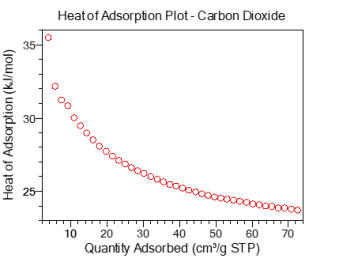




Expertise in the Physical
Characterisation of Materials

MCA Services
Unit 1A Long Barn, North End, Meldreth, Cambridgeshire SG8 6NT UK
01763 262333
© MCA Services




ISOSTERIC HEAT OF ADSORPTION
Heat
of
adsorption
is
a
measure
of
the
strength
of
interaction
between
an
adsorbate
gas
or
liquid
and
a
solid
adsorbent
surface.
Adsorption
is
an
exothermic
process
and
the
heat
of
adsorption
is,
therefore,
the
energy
released
during
the
process
of
adsorption.
The
heat
of
adsorption
is
a
fundamental
thermodynamic
feature
of
the
adsorption
process
and
its
value
can
be
utilised
practically
when
developing
and
assessing
materials
for
a
specific
adsorption
process.
For
applications
of
adsorbents,
separation
processes,
gas
storage
and
catalysis
it
is
often
desirable
to
select
or
develop
materials
with
an
affinity
to
adsorb
a
certain
gaseous
species.
Measurement
of
the
heat
of
adsorption
of
the
specific
gas
onto
the
material is then a very important consideration and is complimentary to knowledge of the porosity of the material.
Measurement
of
the
isosteric
heat
of
adsorption
is
a
common
technique
for
the
calculation
of
the
heat
of
adsorption.
At
least
two
adsorption
isotherms
are
measured
at
different
temperatures
from
which
adsorption
isobars
can
be
derived.
The
isosteric
heat
of
adsorption
is
then
calculated
using
the
Clausius-Clapeyron
equation,
applied
across
an
adsorption
pressure
range
for
which
adsorption
quantities
of
the
isotherms
are
common.
Since
isotherms
covering
a
range
of
adsorption
pressures
are
collected,
a
plot
of
heat
of
adsorption
as
a
function
of
surface
coverage is also plotted.
Key Information:
•
Isosteric heat of adsorption measurement
•
Range of adsorbates available
•
CO2, H2, N2, Ar, O2 and CO commonly applied
•
Measurements from low pressure to saturation
•
Number of isotherms variable from 2 upwards
•
Wide range of analysis temperatures
•
Isotherms close to ambient commonly measured
•
Cryogenic temperature analysis also available
•
Numerical and graphical report formats
•
Heat of adsorption as function of coverage
At
MCA
Services
we
use
our
Micromeritics
3Flex
Micropore
instrument
for
all
heat
of
adsorption
measurements.
A
wide
range
of
temperatures
can
be
applied
to
the
measurement
of
isotherms,
enabling
conditions
which
replicate
the
intended
application
to
be
selected.
For
many
applications,
temperatures
close
to
ambient
are
required
and
our
iso-controller
unit
is
used
to
maintain
a
selected
temperature
between
-5
°C
and +50 °C with excellent stability. Alternatively, temperatures below ambient, to 77 K and temperatures above ambient can also be applied.
The
adsorption
pressures
measured
commence
at
very
low
relative
pressures,
below
atmospheric,
and
usually
extend
to
saturation.
The
heat
of
adsorption
plot
therefore
represents
the
adsorption
process
from
low
coverage
to
saturation
and
is
directly
applicable
to
applications
conducted
at
or
around
atmospheric
pressure.
The
heat
of
adsorption
values
at
low
coverage
are
very
useful
where
further
thermodynamic
calculations
are
being undertaken.






Expertise in the Physical
Characterisation of Materials
MCA Services
Unit 1A Long Barn, North End,
Meldreth, Cambridgeshire SG8 6NT UK
01763 262333
© MCA Services






01763262333
ISOSTERIC HEAT OF ADSORPTION
Heat
of
adsorption
is
a
measure
of
the
strength
of
interaction
between
an
adsorbate
gas
or
liquid
and
a
solid
adsorbent
surface.
Adsorption
is
an
exothermic
process
and
the
heat
of
adsorption
is,
therefore,
the
energy
released
during
the
process
of
adsorption.
The
heat
of
adsorption
is
a
fundamental
thermodynamic
feature
of
the
adsorption
process
and
its
value
can
be
utilised
practically
when
developing
and
assessing
materials
for
a
specific
adsorption
process.
For
applications
of
adsorbents,
separation
processes,
gas
storage
and
catalysis
it
is
often
desirable
to
select
or
develop
materials
with
an
affinity
to
adsorb
a
certain
gaseous
species.
Measurement
of
the
heat
of
adsorption
of
the
specific
gas
onto
the
material
is
then
a
very
important
consideration
and
is complimentary to knowledge of the porosity of the material.
Measurement
of
the
isosteric
heat
of
adsorption
is
a
common
technique
for
the
calculation
of
the
heat
of
adsorption.
At
least
two
adsorption
isotherms
are
measured
at
different
temperatures
from
which
adsorption
isobars
can
be
derived.
The
isosteric
heat
of
adsorption
is
then
calculated
using
the
Clausius-Clapeyron
equation,
applied
across
an
adsorption
pressure
range
for
which
adsorption
quantities
of
the
isotherms
are
common.
Since
isotherms
covering
a
range
of
adsorption
pressures
are
collected,
a
plot
of
heat
of
adsorption
as
a
function
of
surface coverage is also plotted
.
Key Information:
•
Isosteric heat of adsorption measurement
•
Range of adsorbates available
•
CO2, H2, N2, Ar, O2 and CO commonly applied
•
Measurements from low pressure to saturation
•
Number of isotherms variable from 2 upwards
•
Wide range of analysis temperatures
•
Isotherms close to ambient commonly measured
•
Cryogenic temperature analysis also available
•
Numerical and graphical report formats
•
Heat of adsorption as function of coverage
At
MCA
Services
we
use
our
Micromeritics
3Flex
Micropore
instrument
for
all
heat
of
adsorption
measurements.
A
wide
range
of
temperatures
can
be
applied
to
the
measurement
of
isotherms,
enabling
conditions
which
replicate
the
intended
application
to
be
selected.
For
many
applications,
temperatures
close
to
ambient
are
required
and
our
iso-
controller
unit
is
used
to
maintain
a
selected
temperature
between
-5
°C
and
+50
°C
with
excellent
stability.
Alternatively,
temperatures
below
ambient, to 77 K and temperatures above ambient can also be applied.
The
adsorption
pressures
measured
commence
at
very
low
relative
pressures,
below
atmospheric,
and
usually
extend
to
saturation.
The
heat
of
adsorption
plot
therefore
represents
the
adsorption
process
from
low
coverage
to
saturation
and
is
directly
applicable
to
applications
conducted
at
or
around
atmospheric
pressure.
The
heat
of
adsorption
values
at
low
coverage
are
very
useful
where
further
thermodynamic
calculations are being undertaken.























